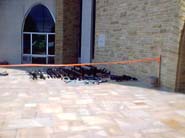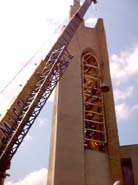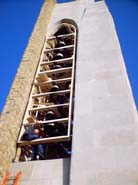

Featured Carillon Projects
First Presbyterian Church, Gastonia, North Carolina
This instrument was installed in a tower originally envisioned for just three large stationary bells. The steel support structures for these bells, which were integral to the structure of the tower, thus having to remain in place, and the triangular shape of the bell space provided a challenge to the original designers. In 1973, a 49-bell carillon was installed by the Eijsbouts firm of The Netherlands. The design worked out at that time was interesting visually, with the bells arranged in two planes, aligned with the large arched openings; however the design was also problematic from the start in practical ways: In order to miss the large “Y” support structures, the downwires were pulled together into two bunches, and then moved back to their original spacing, using wooden guides with metal staples, a cause of much friction and squeaking noises. The fact that the wire array above the keyboard was some wider as designed than the available space between the tower walls meant that the lowest and highest wires rubbed on the stonework; and the fact that the bell lips projected well beyond the perimeter of the structure prevented the installation of bird screens, resulting in an instrument impossible to properly maintain. In approaching this project, we realized early on that an entirely new design would have to be made, to solve these several serious problems. Thus, after considerable study we planned a rearrangement of the bells, retaining some elements of the visual design, but moving all bells inward to permit placement of bird netting in the tone openings of the tower. We were able to establish rows of bells parallel with the wire plane, for a more effective action design. It was also necessary that none of the existing original steel structures interfered with any new downwire positions; a solution for that, and the necessity of limiting the length of the main wire plane were addressed using the inventive solution of establishing two separate wire planes through the bell chamber, down to a set of transfer bars for the bass action located just above the new playing keyboard. New radial action was installed for all bells, and new ball bearing headpieces, cast iron ball clappers and stainless steel bell support bolts were provided. A new practice keyboard was also built, which is located in the choir room. We also provided a new electric swinging ringer for the original church bell, mounted in the tower above the carillon; and reconditioned the electric strikers for the Westminster and hour strike. The instrument was reinstalled and rededicated in 2002, with a recital by Music Director and Carillonneur Mary McFarland.
The bells return home |
New hardware marshaled for hoisting; note ground
floor playing room in background |
The larger bells are hoisted back in |
The installation of the action proceeds |
The new playing keyboard installed; new bass transfer bars may be seen above the back of keyboard |




